
The banking supervision committee of the European Central Bank (ECB) has met this Friday in an extraordinary way to analyze the financial turbulence of the last days and has concluded that it sees no risk of contagion in the eurozone, according to the Reuters agency.
The ECB is stubborn in another rise in interest rates of 0.5 points to 3.5% and increases the risk of a banking crisis
Further
The institution had already told elDiario.es that the objective of “this brief ‘ad hoc’ meeting” was “to exchange points of view and gather updated information on recent events in the banking sector.”
The meeting was called after, this Thursday, the government council was obsessed with another rise in interest rates of 0.5 points, up to 3.5%, despite the fact that it means increasing the risk of a financial crisis .
The great contradiction of the ECB is that it continues to suffocate the economy to fight inflation but insisted on guaranteeing a ‘lifeline’ for the banks, after the collapse of the Silicon Valley Bank in the United States and the bailouts of Credit Suisse in Switzerland and the First National Bank, also in the first economy in the world.
In the institution, monetary policy decisions, such as those announced this Thursday, and banking supervision, whose committee was convened this Friday, are independent. So one meeting does not replace the other. And different knowledgeable sources consider it “natural” for this last committee to react to the turmoil in recent days in the financial markets, both due to the stock market failure of eurozone banks and the fear of new liquidity problems and by massive debt purchases.
According to the same sources consulted by elDiario.es, this Friday there was no need to wait for any official communication from the oversight committee. Next Tuesday, March 21, its president, Andrea Enria, will appear in the European Parliament.
De Guindos: “European banks are resilient”
This Thursday, in its statement, the ECB’s governing council added two extraordinary paragraphs, after three asterisks, in which it states that “it has all the necessary monetary policy instruments to provide liquidity support to the euro area financial system” in in case any problem requires it.
The president, Christine Lagarde, and the vice president of the ECB, Luis de Guindos, defended at a press conference that from “the point of view of financial stability, European banks are resilient and their capital ratios are higher than in 2008” . De Guindos also insisted that the sector’s exposure to Swiss bank Credit Suisse is limited.
The President and Vice President explained that the monetary authority has a wide set of tools that “can be reactivated and are ready to use.” Among them, they cited the Emergency Debt Purchase Program (PPEP), which was designed in response to the shock of the COVID pandemic, or other ways to inject liquidity into banks.
The mistakes of 2008 and 2011
There are many experts who have brought back the bitter memories of the monetary policy errors of the increase in interest rates just before the Great Financial Crisis and later in the midst of the debt crisis. In 2008, the ECB choked the economy at the worst time. In 2011, it dealt a fatal blow to the most indebted states, such as Spain or Greece, which made bailouts inevitable.
Source: www.eldiario.es

